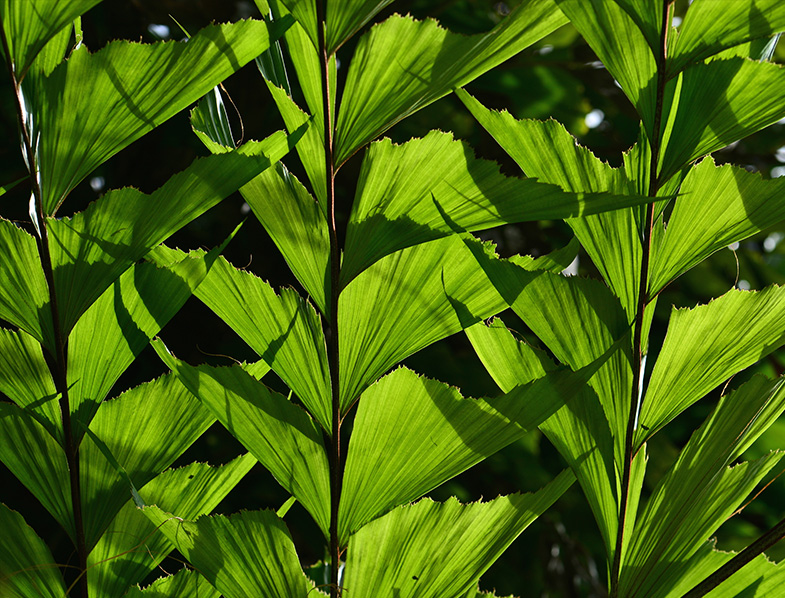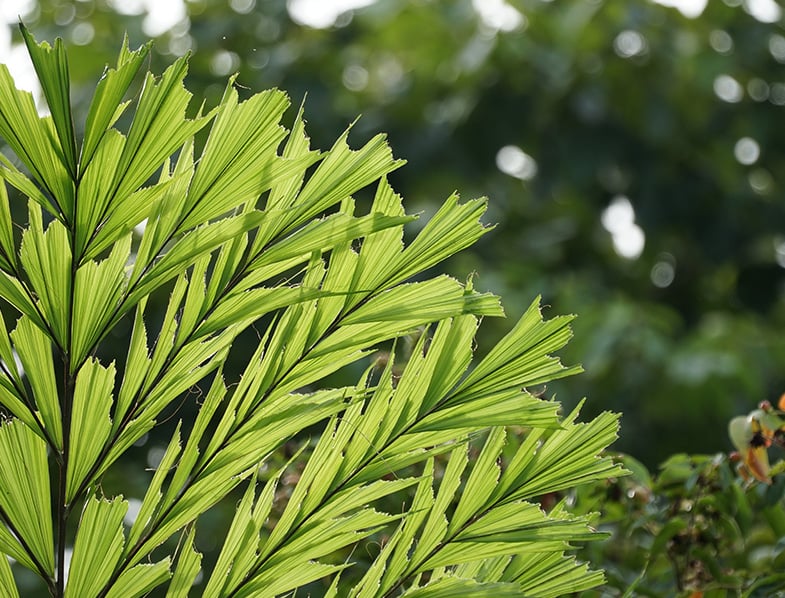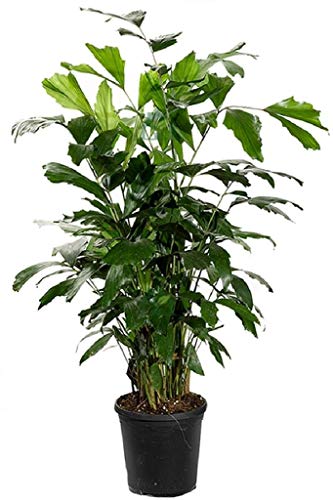The Fishtail palm tree is a nice plant to add to your home or office if you are looking for something that has a unique appearance. Mature Caryota mitis plants have interesting leaves that have a dark green color with rough edges.
The triangle-shaped leaves on a mature plant will seem to split at the ends which makes them look a bit like the tail of a fish. This unique feature is where the Caryota mitis got the common name of the fishtail palm tree.
If you live in a warm climate such as in Florida or the southern West Coast, the Fishtail Palm tree will be a perfect addition to your home or garden. This houseplant thrives in humidity and warm temperatures, which is why it is a common choice for hot locations. It may be a plant that loves balmy climates, but it is relatively easy to cultivate indoors with minimal care.
Though this is a houseplant, it is still a tree. When properly cared for and given plenty of light, it will reach amazing vertical heights. You should place your Caryota mitis in a room that has high ceilings and plenty of space for it to grow. The plant has a moderate growth speed but will live for many years. It only needs to be moved to a new pot when you notice the roots starting to extend through the drainage holes. It prefers tighter areas which will also help prevent it from growing out of control.
About the Fishtail Palm Tree
- The Fishtail Palm Tree has dark green leaves that have ragged edges.
- Unlike many plants that droop, the Caryota mitis grows on stems that are upright.
- The fishtail palm tree is found most often in South Asia and thrives in warm climates.
- This houseplant is a form of tree and will grow to be several feet tall.
- Pinching new fronds will stop the growth of the Caryota mitis.
- If the plant has strange black or brown spots, it is probably suffering from leaf spot fungus.
- The Caryota mitis should only be placed in bright but indirect light.

Fishtail Palm Tree Features: An Overview
- The botanical name of the fishtail palm tree is Caryota mitis.
- The ends of the leaves split as they mature giving them the look of a fishtail.
- Propagating the Caryota mitis is easy thanks to its tendency to grow in clumps.
- The Caryota mitis originates from Southeast Asia.
- The older the fishtail palm tree gets, the lusher it will become.
- Placing a humidifier near the plant will keep the moisture levels balanced.
- The Caryota mitis originated first in Burma, Malaysia.
- The average height of the fishtail palm tree is six feet for indoor varieties.
Growing Fishtail Palm Trees
Growing the fishtail palm tree is easy. It likes warm temperatures, moist soil, and a moderately crowded pot. If you want to limit the plant’s growth to ensure it will fit in your home or office, make sure not to upgrade it to a larger pot until the roots begin to grow out from under the pot.
Though it is a tropical plant, it is important not to allow the soil to become soggy. This will not only lead to root rot, but the plant also will begin to wilt and list if the soil is too wet.
The Caryota mitis is pretty stable once it has matured, but it will always be sensitive to overly dry air. To keep the right level of humidity in dry climates, simply place a humidifier in the room with the plant.

Unlike other house plants, the fishtail palm tree does not need to be pruned often. In fact, you should not cut any branches unless that branch has died. The plant thrives in bright but indirect light during the main growing season.
Caryota mitis plants and all palm trees have growth patterns that start from the branch tips. Cutting off a new frond at the stem will essentially make the plant stop growing. The Pinching new fronds will stop the growth of the Caryota mitis is generally resistant to pests, however, it can develop leafspot fungus on occasion.
To treat the fungus, just remove the affected leaves. Preventing fungus development is easy. Place the fishtail palm tree in an area that has ample circulation and a generous amount of bright light.
Watering Fishtail Palm Trees
Water the fishtail palm tree liberally, but also allow it to dry a bit before you water it again. It is a tropical plant the loves humidity but prefers a dryer soil. In the winter, you should limit the number of times you water the plant to prevent the soil from getting soggy.
There is less growth in the winter, so the fishtail palm tree will consume less water. Tap water often has chlorine and fluoride which is harmful to the fishtail palm tree. It is best to water this tree with distilled water or filtered water instead.

Fishtail Palm Live Plant, From Amazon
Though this lush palm prefers dryer soil, it loves humidity. Unless you live in a balmy climate, it is best to place a humidity gauge in the same room as your plant. Most often, the fishtail palm tree is used as an indoor plant where the air tends to be dry. The minimum humidity needed for this divine plant is 50%. If it drops any lower, consider using a cool-mist room humidifier or a humidity tray to help maintain a proper balance.
The Caryota mitis needs warm to average temperatures ranging between 65 degrees and 85 degrees. They do not tolerate cold very well and should never be placed near or under a vent. Make sure to use a high-quality potting mix with sand added in to allow water to drain from the pot quickly.
A ratio of 3 to 1 of potting mix and horticultural sand will ensure the right level of water drainage. Never use beach sand because the salt in the sand is harmful to palm trees.
Propagating Fishtail Palm Trees
Being that this is a tree, it can’t be propagated from cuttings like other types of house plants. The fishtail palm tree is grown from seeds that should be planted in the spring or summer season.
Make sure to only plant them just under the soil as opposed to deeply burying them. Fishtail palm tree seeds germinate best when only lightly covered and kept in a moist, warm, fresh potting mix.
To boost efficiency, use a seedling heat mat to keep a steady temperature of about 70 degrees. Once the seeds sprout, you are on your way to new plants. When you are ready to propagate the fishtail palm tree after they sprout, all you have to do is divide the stems that rise from the clumps at the base of the offsets.
After gently separating the clumps, pot the offsets in individual pots. Feed the trees once yearly at the start of summer with a palm specific slow-release fertilizer.

Conclusion
Fishtail palm trees are highly attractive bushy plants that are perfect for indoor cultivation. The fronds of the tree look a bit like the tail of a fish which is how it got its moniker. Mature healthy palms will become clumps making it a thick feature in any room. Most people house their trees in large pots and place them in atriums, walkways, foyers, and waiting rooms. While they require minimal maintenance, they do need space to grow vertically. They also need strong bright light, but not direct sunlight.
The palm with grow best in a peat-based soil, or you can use a coir-based potting mix with added material. This material will ensure that the plant drains properly and doesn’t develop soggy roots.
You can use perlite or pine bark to help the mix drain, or you can use plant sand as well. Make sure to feed your palm a weak liquid fertilizer once or twice during the growing seasons, but skip it in the winter. If you want to keep your tree alive longer, occasionally mix a small amount of Epsom salt in the soil to stave off magnesium deficiency.
These bushy bits of nature love warm temperatures and plenty of moisture, but be sure not to overwater them. Most indoor spaces are a bit dry, so make sure to keep a relative humidity of at least 50%. They are slow-growing and will live for many years if properly cared for.
Older trees have been known to grow as tall as 20 feet, but the average height of an indoor fishtail tree is six feet. Plant them in coir-based potting soil that is well-draining to prevent root rot and to support healthy growth.

1 Comment
Are their fruit poisonous ? Would you recommend growing this plant in home garden ?